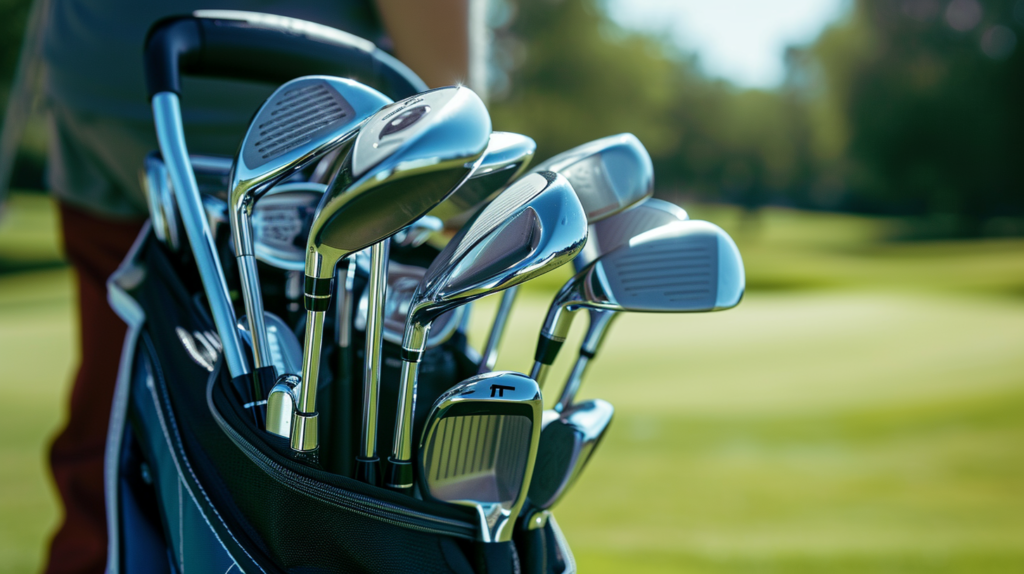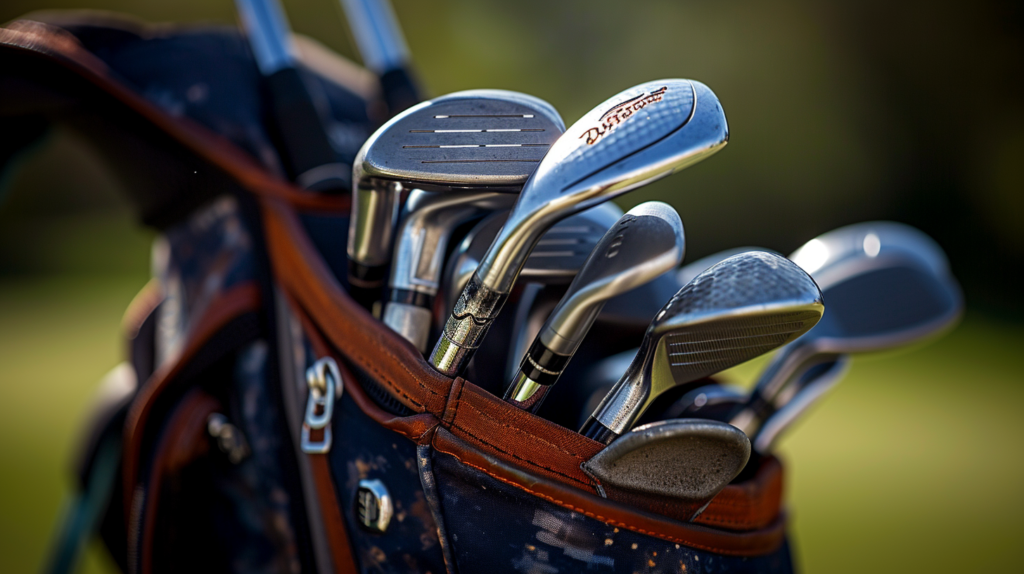Searching through a disorganized golf bag for the right club can feel like climbing out of a greenside bunker. It’s frustrating and slows down your whole group.
Arranging your golf bag deliberately by club type, frequency of use and specific course demands will speed up play and simplify shot selection.
Let’s dive into key golf bag organization tips so you can focus on swinging not sorting equipment this season.
1. Keep the Essentials Handy

Having quick and easy access to the golf clubs you use most often during a round is key to staying focused and playing efficiently. The last thing you want is to fumble around your bag searching for the right club, slowing down play.
Therefore, keep your essential clubs in the most accessible pockets or slots in your golf bag design.
Specifically, you’ll want to prioritize room for your driver, putter and pitching wedge in areas where you can grab them quickly. These clubs cover common shot types off the tee, on the greens and approaches requiring loft or finesse.
Place them in the top pockets or divider slots closest to the top opening of the bag so they are ready to pull out right away. Consider placing the putter by itself in a dedicated putter well if your golf bag has one.
This keeps it isolated from other clubs to prevent damage to the grip or head.
In addition to key clubs, also keep small essential accessories within reach for convenience during the round. These items include extra gloves, tees, ball markers, divot repair tools and even an extra ball or two.
Look for pockets, slots or exterior clips on the golf bag to store these for easy mid-round access. Avoid digging deep to find what you need.
Quick grabs preserve pace of play and concentration.
With convenient access to essential clubs and accessories, you save time and simplify decisions from shot to shot. This allows you to focus energy on the game rather than the bag.
Get your most common clubs and necessities handy, then organize the rest accordingly.
2. Group Clubs by Type

Golf bags come in all shapes and sizes these days with a variety of divider configurations and pocket designs. But no matter the features, some fundamental organization principles apply across the board.
An effective system is to group clubs together based on their type and attributes.
Start by keeping your woods together in one section of the bag, whether that is along one side wall of a cart bag or within a top row of slots in a carry bag. The woods group would include your driver and any fairway woods or utility clubs.
This separates them from the other longer length clubs since you use woods less frequently than irons over a full round.
Next, gather all your irons together in a larger portion of the bag’s storage capacity. You may want to further subgroup them by type of iron.
Place the lower lofted long irons (2-4) together in one set of slots, mid irons (5-7) in another, and short irons (8-PW) in a third set. This allows you to quickly narrow club selection by distance as you approach the green.
Wedges are the final key club type to group, keeping those with higher lofts for sand shots, chipping and specialty finesse shots within close reach. Putter gets its own dedicated slot as well, separating it from other flat stick clubs.
This organization by club type makes it natural to default to the right part of the bag for any given shot situation.
It’s also smart to consider the golf bag design itself when grouping clubs. Bags may have full length dividers, a few partial dividers or no dividers at all.
Full length dividers provide separation between every club but take up more space. Partial dividers help isolate woods and putter but irons may still contact each other.
Getting an even mix of woods and irons along both sides can help balance weight distribution too. Ultimately choose a bag that enables your desired grouping by type.
Establishing a grouped organization system among wood woods, irons, wedges and putter makes club selection easier. You intuitively reach for the right club type without the mental clutter of them being mixed randomly together.
This efficiency leaves more brain power for dialing in the best shot shaping, alignment and distance for each swing rather than just figuring out which club to use.
3. Arrange by Frequency of Use

Every golfer has a set of go-to clubs they rely on more often during the typical round. For most, these include higher lofted irons, wedges and putter used predominantly for approaches, short game and on the greens.
Therefore, an effective way to arrange clubs within your organizer bag is by frequency of use from most often used to least.
Place the clubs you hit most in a round closest to the top opening of the bag for most convenient access. This would likely be your mid irons through wedges (6-iron down to lob wedge) along with the putter up top by itself.
Having them in the upper part of the bag minimizes reach and hassle pulling them in and out several times a round. It also balances weight by keeping the heavier woods and lower irons at the bottom.
The clubs used less often can go behind the frequent fliers including your lower numbered long irons, fairway woods and driver (assuming you keep this handy in a side pocket anyway).
You probably only hit a few tee shots, long approaches or trouble shots in a full 18 holes where those clubs come into play. Keep them more out of the way until the rare occasion you do need to grab one.
Alternatively, you might arrange by frequency of use across the divider slots from front to back. For a carry bag, the clubs used most get slots closest to the back padding that rests against your body for the easiest access.
Woods and lesser used irons go farther forward since grabbing them is less cumbersome on the walk between shots. A cart bag could use this front to back system as well.
Customizing organization by frequency of use varies between golfers if certain clubs fall in or out of favor for your personal game. But the main objective is having instant access to the wedge through mid iron go-tos without hassling with other less used clubs in the way.
This system keeps delays to a minimum for those common grabs we all make multiple times in a round.
4. Customize for Course Conditions

While having an established organization system in your golf bag is important for efficiency, it’s also wise to customize setups based on the course conditions you face most often. Certain clubs work best on certain courses, so why keep them all handy if you likely won’t use them all.
Prepare your bag setup to best attack the courses in your regular rotation.
For example, if playing predominantly on a narrow, tree-lined course requiring greater accuracy off the tee, prioritize keeping your lower trajectory, higher control driver and fairway woods close at hand.
Move any ultra low-spin bombs or unforgiving blades back into the depths where they are less convenient. Bring control woods and irons up front instead since you lean on them more frequently.
Similarly, on a shorter executive or par-3 course, you can minimize the woods altogether and keep most of your wedge collection conveniently up top. Take out lower irons completely knowing you likely won’t need long approaches.
Customizing to emphasize only the clubs demanded by a certain course helps simplify decisions and bag access.
Beyond course layout, also consider common weather conditions when tweaking club accessibility. Places with consistent wind likely require knocking down trajectories more often by reaching for lower lofted irons and shallow faced woods kept handy.
Meanwhile in soft conditions from rain, having bunker escape and heavy rough clubs close speeds up recovery shots that come into play more.
Don’t be afraid to swap out certain clubs in and out of the main compartments too when playing matches across varying course landscapes.
A bag insert can hold the overflow that doesn’t make the cut for that day’s starting lineup while keeping top-used ones efficiently arranged. Adjust to the course and conditions but maintain organization habits accordingly.
5. Balance the Weight

An underrated but very important aspect of golf bag organization is distributing weight appropriately for comfort and stability.
While arranged logically by type, usage and conditions as previously covered, you also want clubs positioned to balance bag weight across shoulders and stand legs. An unbalanced wanders more aggravatively when carrying and risks toppling over if poorly supported upright.
A good guideline is arranging woods down one side of the bag and irons down the other. Woods with their heavy heads naturally weigh more than irons and put weight lower in the profile.
So group woods together in a top-to-bottom column along one wall of the bag or row of divider slots. Then fill the opposite side with irons and wedges concentrated higher.
This helps split weight more evenly side to side.
You can further aid balanced weight distribution by arranging woods with their headcovers on to concentrate density low on one side. Then do the opposite by placing irons head-down to concentrate their weight higher on the opposite side.
This minor tweak makes efficient use of gravity to achieve sturdy balance. It also protects club faces from dings.
For carry bags, pay attention to how the weight sits against your body once on your shoulders. It may work best to have the heavier woods side pressed against your side or back.
This centers mass neutrally rather than allowing it to pull annoyingly in one direction if off balance. Get the overall weight aligned comfortably down your spine.
Achieving evenly balanced weight posture makes carrying or maneuvering the bag much less cumbersome. And the bag stands steadily upright rather than dipping left or right if weighting is distributed effectively.
It may take a few adjustments, but concentrating woods low on one side and irons higher on the other side helps reach that crucial centered balance both wearing and standing.
Conclusion
In closing, effectively organizing your golf bag saves time, simplifies decisions, balances weight, and customizes your setup for course conditions.
Keeping essential clubs instantly accessible while grouping remaining clubs logically by type, usage frequency, and required shot shapes will lead to greater efficiency on the course.
This allows you to focus energy completely on skillfully navigating each hole rather than hassling with your equipment. Implement these golf bag organization tips to streamline your next round.


